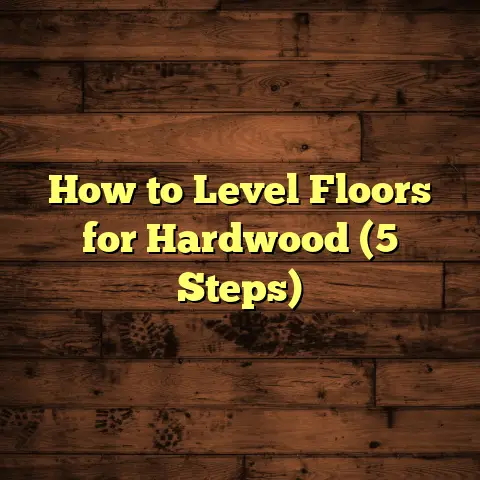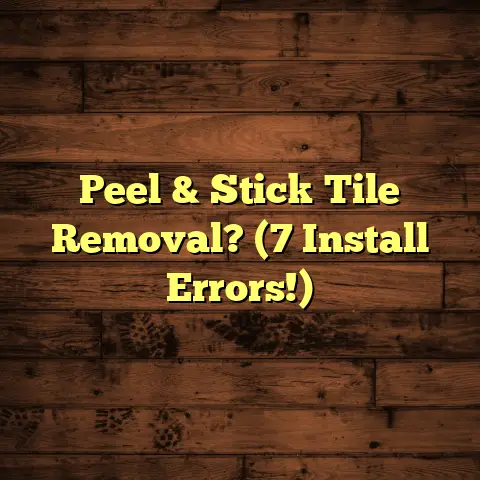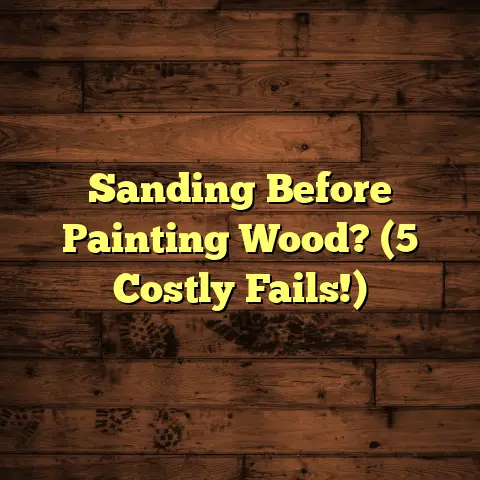Under Vinyl Flooring: What’s Best? (3 Subfloor Sins!)
(3 Subfloor Sins!)
Vinyl flooring, right? It’s a fantastic choice for both homes and businesses. Why? Well, let’s talk economics. It’s generally more budget-friendly upfront than, say, hardwood or tile.
But the real savings? They come later.
Think about it: vinyl is incredibly durable. It can handle a ton of foot traffic, resists scratches, and shrugs off water like it’s nothing. That means less need for repairs or replacements down the road. Plus, maintenance is a breeze – just a quick sweep and mop, and you’re good to go.
And here’s a bonus: many vinyl options offer great insulation. That can translate to lower energy bills, keeping your place warmer in winter and cooler in summer. It’s a win-win!
Now, here’s where things get interesting: the unsung hero beneath that beautiful vinyl – the subfloor. Think of it as the foundation of your flooring system. Choosing the right subfloor? That’s absolutely critical. Mess it up, and you’re looking at potential problems like bubbling, cracking, and even complete floor failure. Trust me, I’ve seen it all!
That’s why investing in a quality subfloor is just as important as the vinyl itself. It can prevent those costly repairs and replacements I mentioned earlier. It’s all about setting yourself up for long-term success and avoiding future headaches.
In this article, I’m going to walk you through everything you need to know about subfloors and vinyl flooring. We’ll dive into the different types of subfloors, how to assess their condition, and, most importantly, how to avoid the three deadly “subfloor sins” that can completely ruin your vinyl flooring experience.
Ready to get started? Let’s do this!
Section 1: Understanding Subfloors
So, what exactly is a subfloor? Simply put, it’s the layer of material directly beneath your finished floor covering – in this case, vinyl. It’s the foundation that provides a smooth, stable, and level surface for your vinyl to sit on.
Think of it like this: the subfloor is the bread to your vinyl flooring sandwich. Without good bread, the whole sandwich falls apart, right?
The importance of a proper subfloor can’t be overstated. It affects everything from the way your floor feels underfoot to its overall lifespan. A solid subfloor prevents flexing, squeaking, and other annoying issues that can arise from an unstable base.
Now, let’s talk about the different types of subfloors you’re likely to encounter:
- Concrete: Common in basements and ground-level slabs, concrete subfloors offer excellent stability. However, they can also be prone to moisture issues, which we’ll dive into later.
- Plywood: A popular choice for upper floors, plywood is relatively lightweight, strong, and easy to work with. Look for exterior-grade plywood for added moisture resistance.
- OSB (Oriented Strand Board): OSB is another engineered wood product often used as a subfloor. It’s generally more affordable than plywood, but it can be more susceptible to moisture damage.
- Existing Flooring (Sometimes): In some cases, you might be able to install vinyl over an existing floor, like tile or linoleum. However, this requires careful preparation and assessment to ensure a solid, level surface.
The condition and type of your subfloor will significantly impact the installation and longevity of your vinyl flooring. A cracked, uneven, or moisture-ridden subfloor can lead to a whole host of problems, regardless of how high-quality your vinyl is.
So, what are the critical factors to consider when selecting a subfloor for vinyl flooring?
- Moisture Levels: This is huge. Vinyl is water-resistant, but it’s not waterproof. Excess moisture in the subfloor can lead to mold, mildew, and adhesive failure. I’ve seen floors completely ruined by this!
- Stability: A stable subfloor is essential to prevent movement and flexing, which can cause vinyl to crack or tear.
- Evenness: An uneven subfloor will telegraph through the vinyl, creating unsightly bumps and dips. It can also lead to uneven wear and tear.
For example:
According to the Resilient Floor Covering Institute (RFCI), subfloor flatness should be within 3/16 inch over a 10-foot span for most vinyl flooring installations. That’s pretty darn flat! Source: https://www.rfci.com/
Now that we’ve covered the basics of subfloors, let’s move on to the first deadly sin: moisture issues.
Section 2: The First Subfloor Sin – Moisture Issues
Okay, let’s talk about moisture. I can’t stress enough how critical this is. Moisture is the silent killer of vinyl flooring!
How can moisture compromise your vinyl flooring? Let me count the ways:
- Mold and Mildew: Excess moisture creates the perfect breeding ground for mold and mildew, which can not only damage your flooring but also pose serious health risks.
- Warping and Buckling: Moisture can cause the subfloor to swell and warp, which, in turn, can cause your vinyl flooring to buckle and lift.
- Adhesive Failure: Many vinyl flooring installations rely on adhesives to bond the vinyl to the subfloor. Moisture can weaken these adhesives, leading to loose or peeling vinyl.
I remember one job where a homeowner had installed a beautiful new vinyl floor in their basement. Within a few months, they started noticing a musty smell and the vinyl began to bubble up in several spots. Turns out, the concrete subfloor had a high moisture content, and they hadn’t installed a proper moisture barrier. The entire floor had to be ripped up and replaced – a very costly mistake!
That’s why moisture testing is absolutely essential before installing any vinyl flooring, especially in basements or areas prone to spills and leaks.
There are several ways to test for moisture in a subfloor:
- Calcium Chloride Test (for concrete): This involves placing a small container of calcium chloride on the concrete surface, sealing it with a plastic dome, and measuring the amount of moisture absorbed over a 72-hour period.
- Moisture Meter: These handheld devices can measure the moisture content of wood or concrete. Look for a meter that’s specifically designed for flooring applications.
- Plastic Sheet Test: Tape a piece of clear plastic sheeting to the subfloor and leave it for 24-48 hours. If condensation forms under the plastic, it indicates the presence of moisture.
If your moisture tests come back positive, don’t panic! There are solutions. The most common is to install a moisture barrier.
What kind of moisture barriers are available?
- Polyethylene Film: This is a simple and affordable option that can be installed over concrete subfloors to prevent moisture from seeping up.
- Liquid-Applied Membranes: These are rolled or brushed onto the subfloor to create a waterproof barrier. They’re a good choice for concrete subfloors with moderate moisture issues.
- Underlayment with Integrated Moisture Barrier: Some underlayments come with a built-in moisture barrier, offering both cushioning and moisture protection.
Here’s an example:
Let’s say you’re installing vinyl flooring in a basement that’s known to have some moisture issues. You test the concrete subfloor and find that the moisture content is higher than recommended. In this case, you might consider using a liquid-applied membrane to create a robust moisture barrier, followed by a quality underlayment for added protection and comfort.
Beyond moisture barriers, there are other steps you can take to address moisture problems:
- Improve Drainage: Ensure that your property has proper drainage to prevent water from pooling around the foundation.
- Fix Leaks: Address any plumbing leaks or roof leaks promptly to prevent water from seeping into the subfloor.
- Use a Dehumidifier: In damp environments, a dehumidifier can help to lower the humidity levels and prevent moisture buildup.
Don’t underestimate the power of moisture control! Taking the time to address moisture issues before installing your vinyl flooring can save you a lot of headaches and money in the long run.
Now, let’s move on to the second subfloor sin: improper leveling.
Section 3: The Second Subfloor Sin – Improper Leveling
Alright, let’s talk about levelness. A perfectly level subfloor is the key to a beautiful, long-lasting vinyl floor. Think of it like this: if you’re building a house, you need a level foundation, right? The same principle applies to flooring.
What happens when you install vinyl flooring over an uneven subfloor? A whole lot of bad things:
- Vinyl Buckling: Unevenness can cause the vinyl to buckle and lift in certain areas, creating unsightly bumps and dips.
- Tearing: When the subfloor isn’t level, the vinyl can be stretched and stressed in certain areas, leading to tears and cracks.
- Premature Wear: Unevenness can cause the vinyl to wear unevenly, with some areas wearing out much faster than others.
I’ve seen so many floors ruined by this. One time, I was called in to inspect a vinyl floor that had been installed just a few months earlier. The homeowner was complaining about bubbles and cracks appearing all over the floor. When I checked the subfloor, it was a disaster! There were dips and humps all over the place, some as big as half an inch. The installer had clearly skipped the leveling step, and the result was a complete flooring failure.
So, how do you assess the levelness of a subfloor? Here are a few tools and methods you can use:
- Straight Edge and Level: Place a long straight edge (at least 6 feet long) on the subfloor and use a level to check for any gaps or high spots.
- Long Level: A long level (4-6 feet) can also be used to check for levelness.
- Self-Leveling Laser Level: This is a more advanced tool that projects a laser line across the subfloor, allowing you to easily identify any unevenness.
- Visual Inspection: Sometimes, you can spot unevenness simply by looking at the subfloor. Look for dips, humps, or cracks.
For example:
Grab a 6-foot straight edge and a level. Place the straight edge on the subfloor and check for gaps. If you see a gap larger than 3/16 of an inch over a 10-foot span, that’s an area that needs to be leveled.
Now, let’s say you’ve assessed your subfloor and found that it’s not level. What are your options for leveling it?
- Self-Leveling Compound: This is a cement-based mixture that you pour onto the subfloor. It flows into the low spots and levels itself out, creating a smooth, even surface. Self-leveling compound is a great option for concrete subfloors or plywood subfloors with minor imperfections.
- Floor Patch: This is a trowel-able compound that you can use to fill in small cracks, holes, or dips in the subfloor. Floor patch is a good option for spot repairs.
Here’s a tip:
When using self-leveling compound, be sure to follow the manufacturer’s instructions carefully. Proper preparation is key to a successful application. You’ll need to prime the subfloor, mix the compound correctly, and pour it evenly.
Leveling an uneven subfloor can be a bit of work, but it’s well worth the effort. A level subfloor will not only improve the appearance of your vinyl flooring but also extend its lifespan and prevent costly repairs down the road.
Now that we’ve conquered the second subfloor sin, let’s move on to the third and final sin: inadequate support.
Section 4: The Third Subfloor Sin – Inadequate Support
Okay, we’ve talked about moisture and levelness. Now, let’s get into structural integrity. Inadequate support in your subfloor can be a recipe for disaster, leading to flexing, sagging, and ultimately, damage to your beautiful vinyl flooring.
Why is adequate support so important? Well, think about it: your subfloor needs to be strong enough to handle the weight of your furniture, appliances, and foot traffic. If it’s not, it will start to flex and sag over time.
What happens when a subfloor lacks adequate support?
- Flexing: When you walk on the floor, you might notice that it feels bouncy or springy. This is a sign that the subfloor is flexing under the weight.
- Sagging: Over time, the subfloor can start to sag, creating noticeable dips in the floor.
- Damage to Vinyl Flooring: Flexing and sagging can put stress on the vinyl flooring, causing it to crack, tear, or delaminate.
I’ve seen floors where you could literally feel the subfloor moving under your feet. It’s not a good feeling! And it’s definitely not good for your flooring.
So, how do you know if your subfloor has adequate support? Here are a few things to look for:
- Bouncy or Springy Feel: As mentioned earlier, if the floor feels bouncy when you walk on it, that’s a sign of inadequate support.
- Visible Sagging: Look for any dips or low spots in the floor.
- Squeaking: Squeaking floors are often a sign that the subfloor is rubbing against the joists due to inadequate support.
- Cracks in the Subfloor: Cracks in the subfloor can indicate that it’s under stress.
If you suspect that your subfloor lacks adequate support, it’s important to address the issue before installing your vinyl flooring.
What can you do to reinforce a subfloor that’s too flexible or sagging?
- Add Additional Joists: If the joists (the horizontal beams that support the subfloor) are spaced too far apart, you can add additional joists to provide more support.
- Sister the Joists: This involves attaching new joists to the existing joists to strengthen them.
- Add Support Beams: In some cases, you may need to add support beams to the underside of the subfloor to provide additional support.
For example:
Let’s say you’re installing vinyl flooring in an older home where the joists are spaced 24 inches apart. This is a wider spacing than is typically recommended for vinyl flooring, which can lead to flexing. In this case, you might consider adding additional joists to reduce the spacing to 16 inches, providing more support for the subfloor.
Here’s a real-world example:
According to the American Wood Council, the maximum joist spacing for a typical residential floor is 16 inches on center. Source: https://www.awc.org/
If you’re not comfortable reinforcing the subfloor yourself, it’s best to hire a qualified contractor to do the work. They can assess the situation and recommend the best course of action.
Don’t skip this step! Ensuring that your subfloor has adequate support is crucial for the long-term performance and appearance of your vinyl flooring.
Conclusion
Wow, we’ve covered a lot of ground! Let’s recap the key points:
- Subfloors are the foundation of your vinyl flooring system. Choosing the right subfloor is essential for a successful installation.
- Moisture is the enemy of vinyl flooring. Always test for moisture and install a proper moisture barrier if necessary.
- A level subfloor is crucial for a beautiful, long-lasting vinyl floor. Take the time to level any unevenness before installing the vinyl.
- Adequate support is essential to prevent flexing and sagging. Reinforce the subfloor if needed to ensure that it can handle the weight of your furniture and foot traffic.
By avoiding these three “subfloor sins” – moisture issues, improper leveling, and inadequate support – you can ensure that your vinyl flooring looks great and lasts for many years to come.
Remember, addressing these issues upfront can save you a lot of money and headaches in the long run. It’s an investment in the longevity and beauty of your flooring.
If you’re unsure about any aspect of subfloor preparation, don’t hesitate to seek professional advice. A qualified flooring contractor can assess your subfloor, recommend the best course of action, and ensure that your vinyl flooring is installed correctly.
Thanks for taking the time to learn about subfloors and vinyl flooring! I hope this article has been helpful. Now go out there and create the beautiful, durable floors of your dreams!





